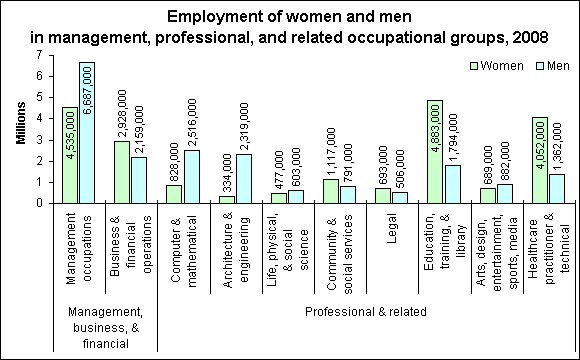August 07, 2009
(The Editor’s Desk is updated each business day.)
Women and men in management, professional, and related occupations, 2008
Women working in full-time management, business, and financial operations jobs had median weekly earnings of $941 in 2008, more than women earned in any other major occupational category. The second-highest paying job group was professional and related occupations, in which women earned $867 per week.

[Chart data—TXT]
In management, business, and finance, the highest paying occupations for women were chief executives and computer and information systems managers. Within professional and related occupations, women working as pharmacists or lawyers had the highest median weekly earnings.

[Chart data—TXT]
Although women are more likely than men to work in professional and related occupations, they are not as well represented in the higher paying job groups within this broad category.
In 2008, only 9 percent of female professionals were employed in the high-paying computer and engineering fields, compared with 45 percent of male professionals. Professional women were more likely to work in the education and health care occupations, in which pay was generally lower. Sixty-eight percent of female professionals worked in these fields in 2008, compared with 29 percent of male professionals.
These earnings data are from the Current Population Survey. More BLS data on the subject of women's earnings may be found in "Highlights of Women's Earnings in 2008" (PDF), BLS Report 1017.
Related TED article
Of interest
Spotlight on Statistics: National Hispanic Heritage Month
In this Spotlight, we take a look at the Hispanic labor force—including labor force participation, employment and unemployment, educational attainment, geographic location, country of birth, earnings, consumer expenditures, time use, workplace injuries, and employment projections.
Read more »

